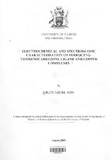| dc.description.abstract | Electrochemical and spectral behavior of two thiosemicarbazone ligands, containing
ferrocene as a substituent and their two copper complexes; as well as a ligand with no
ferrocene substituent and its copper complex were studied using cyclic voltammetry,
ultraviolet-visible (UV/Vis) spectroscopy and infrared (IR) spectroscopy.
The ligands included: acetylferrocenyl-4-phenylthiosemicarbazone (Dan 1),
acetylpyridine-2-thiophenecarboxylsemicarbazone (Dan 5), acetylferrocenyl-2-
thiosemicarboxyl-semicarbazone (Dan 11). Their respective copper complexes were Dan
2, Dan 6 and Dan 12.
Ferrocene and Potasium ferrocyanide were used as standards and they gave reversible
voltamograms of one electron transfer due to Fe+2IFe+3 redox couple and diffusion coefficient of2.8x 10 -5± 0.08cm2s-' and 7.0 x 10 -6 ± 0.03cm2s-', respectively, which was
comparable to the literature value. Preliminary work also involved characterization of a
Nitrosyl ligand 4-phenacetylidene-2,2,5,5-tetramethyl-3-imidazolidin-I-oxyl nitroxyl,
which was done in order to ensure that the electrochemical procedure followed was
appropriate for the current research wok. It was possible to reproduce the voltammetric
behavior of the nitrosyl ligand.
All the Thiosemicarbazone ligands gave well defined cyclic voltamograms. Dan 1
showed a reversible voltammogram at a scan rate of 0.030v/s, where the ratio of anodic
current and cathodic current was approximately unity, thus confirming reversibility. Its
cathodic to anodic peak potential difference (i'1E) increased with scan rate which is
characteristic of slow electron transfer. Dan 2 which was the copper complex of Dan 1 gave a reduction and oxidation peak at -0.494 V and -0.21 V Vs SCE reference electrode,
respectively.
The peak ratio was greater than unity which is common in transition metal complex due
to shift in the geometry of coordination sphere. The ratio decreased with the scan rate and
came closer to unity at higher scan rates, which suggested a chemical reaction follow up,
showing that the oxidation product was not stable. This phenomenon was observed in all
other copper complexes, but their peak potentials differed depending on the side chains of
the thiosemicarbazone ligand. Dan 5 exhibited a one electron transfer reversible
voltamogram where the current ratio (iPa/ipc )was approximately unity and i\E was
0.084± 0.01 V. Dan 11 also gave a one electron electron transfer at a scan rate of 0.025
Vis. i\E was 0.065± 0.01 versus SCE.For the three ligands and the three metal complexes UV/visible spectral gave a weak
absorption peak at 450nm and this was attributed to weakly allowed asymmetrical d-d
transition for the metal in the ligand and the two metals in the complex. Intense separate
peaks of shorter wave lengths (Amax) were observed for all compounds which are
characteristics of charge transfer absorption peaks.
When the ligand (Dan 1) was complexed with copper to form Dan 2 UV-Vis exhibited
blue shift, i.e., the absorption peak of the complex shifted to shorter wavelength,
suggesting transfer of electron from the ligand into the d orbitals of the metal (ligandmetal
charge transfer), which is predominant if complexes have ligands with relatively
high energy lone pairs (example Sulphur) or if the metal has low lying empty d orbitals.
When the ligand (Dan 5) was complexed with copper to form Dan 6 UV -Vis exhibited red shift suggesting metal-ligand charge transfer, similar to what was observed for Dan
11 and 12.
IR spectrophotometry confirmed the bidentate character of Dan 1 and Dan 11 ligands for
the copper complexes. C=N band of the thiosemicarbazone which appeared at 1601cm-1
in Dan 1 shifted towards lower wave number in Dan 2, indicating coordination via
nitrogen to the copper metal. The band at Sl Scm', corresponding to C=S was shifted
towards lower wave numbers when complexed with copper metal, which indicates
presence of thione sulphur coordination. Other characteristic bands observed were
1650cm-1 for C=O, 3367cm-1 for N-H andl041cm-1 for N=N. The above Thiosemicarbazone (Dan 1, Dan 2, Dan 5, Dan 11 and Dan 12) are known to
exhibit bioactivity properties from previous research work hence the recommendation for
further work to correlate the present research results to the bioactivity of the compound.
- | en |

